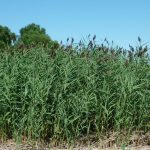 Throughout the Great Lakes region, a very tall, densely growing grass known as Phragmites australis or common reed grass, has taken over areas of roadsides, wetlands and lake shorelines. Over the last few years, a great deal of work has been done to try to control large patches of the non-native invasive strain of this species, particularly on the shores of Lake Michigan and Green Bay. These large scale control projects can take a lot of time and resources, but if phragmites populations are caught early, control can be much easier.
Throughout the Great Lakes region, a very tall, densely growing grass known as Phragmites australis or common reed grass, has taken over areas of roadsides, wetlands and lake shorelines. Over the last few years, a great deal of work has been done to try to control large patches of the non-native invasive strain of this species, particularly on the shores of Lake Michigan and Green Bay. These large scale control projects can take a lot of time and resources, but if phragmites populations are caught early, control can be much easier.
Recently the DNR received $200,000 from the US Fish and Wildlife Service’s Great Lakes Restoration Initiative (GLRI) fund to implement a new Phragmites control project within Wisconsin’s Lake Michigan basin. The stated purpose of the project is to find the leading western edge of the Phragmites invasion and “push” it back toward Lake Michigan. In many Wisconsin counties, especially in the western Lake Michigan basin, the non-native strain of Phragmites is a newly establishing invasive wetland or lakeshore plant. Efforts now to prevent its establishment and spread there will help prevent many of our inland lakes and wetlands from encountering the problems this plant has caused in other areas of the Great Lakes region.
This project will focus first on eliminating non-native Phragmites in those counties in the far northwestern part of the Lake Michigan basin, then move south and east through the counties along the western edge of the basin, as funding allows. The goal is to treat at least 200 acres of non-native Phragmites, beginning in late summer 2014, with follow-up treatments in 2015 (even through 2017). DNR is reaching out to partners that may have location data in order to build a map of non-native Phragmites populations across the state that will guide control activities for this project – contact details are at the end of the article.
The project targets newly establishing Phragmites infestations and may take place in areas such as wetlands, lakeshores, rights-of-way, State Natural Areas, parks and adjoining private lands. Other criteria such as the availability of partner organizations, prior control work done, and the existence of rare species will guide site selection. Phragmites can spread quickly to new areas by underground rhizomes, above ground runners or stolons, stem fragments (e.g., from mowing), and by seeds that germinate readily in disturbed ground or exposed lakebeds.
Control treatments of Phragmites patches are most effective if all parts of an infestation are treated, which means that getting all landowners of a site to agree to treatment is important for success. Aquatic formulas of herbicides such as glyphosate or imazapyr applied by certified applicators are commonly used because Phragmites is a resilient species and may become more robust if other treatments such as mowing are done at the wrong time of year. The best way to control Phragmites is to try and catch it early before it becomes well-established.
This project is still actively seeking reports of Phragmites, and reports can be sent to the DNR in a number of ways – you can email invasive.species@wi.gov or learn how to send in any sightings you have on our wetland invasive reporting website. (Adding site info to data bases, such as GLEDN, EDDMAPS, etc. may also get your info to us, but tell us if you are using outside data repositories so we can mine them.) A great online resource to learn a lot more about this invasive plant, and ways to control it, is found at the Great Lakes Phragmites Collaborative website.
For specific questions about this project contact Brock Woods, WDNR/UWEX Program Coordinator (brock.woods@wisc.edu), or Jason Granberg, Wetland Invasive Species Specialist (Jason.Granberg@wisconsin.gov).



